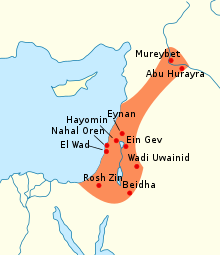纳图夫文化
纳图夫文化(英语:Natufian culture,发音/nəˈtuːfiən/[1])是一个在黎凡特地区的旧石器时代晚期考古学文化,该文化约发生于距今约 15,000 至 11,500 年前。[2] 这种文化很不寻常,因为它甚至在农业被引入前,就已支撑起过着定居或半定居生活的人口。

纳图夫社群可能是其所在地区最初的新石器时代定居点的建造者的祖先。在位于今叙利亚上幼发拉底河谷的史前文化考古遗址 Tell Abu Hureyra,证据显示该文化有意种植谷物,特别是黑麦。[3] 面包制作证据在约旦东北部沙漠里约有14,500年历史的 Shubayqa 1 号遗址中被发现。[4] 此外,在以色列海法附近迦密山的 Raqefet 洞穴中发现了古老的啤酒制造证据,其发生时间可追溯到约13,000年前。[5][6]
同时,这个文化的人群会利用野生谷物并猎杀包括瞪羚在内的动物。[7] 考古遗传学已揭示后期(新石器时代到青铜器时代)黎凡特人的起源,主要来自该文化之人群,还有大量来自安纳托利亚铜石并用时代的混合产物。[8]
参考资料 编辑
- ^ Natufian. 牛津英语词典 (第三版). 牛津大学出版社. 2005-09 (英语).
- ^ Grosman, Leore. The Natufian Chronological Scheme – New Insights and their Implications. Bar-Yosef, Ofer; Valla, François R. (编). Natufian Foragers in the Levant: Terminal Pleistocene Social Changes in Western Asia 1. New York: Berghahn Books. 2013: 622–627 [2021-11-14]. ISBN 978-1-879621-45-9. JSTOR j.ctv8bt33h. (原始内容存档于2022-01-30) –通过JSTOR.
- ^ Moore, Andrew M. T.; Hillman, Gordon C.; Legge, Anthony J., Village on the Euphrates: From Foraging to Farming at Abu Hureyra, Oxford: Oxford University Press, 2000, ISBN 978-0-19-510806-4
- ^ Prehistoric bake-off: Scientists discover oldest evidence of bread. BBC. 17 July 2018 [17 July 2018]. (原始内容存档于2020-05-19).
- ^ 'World's oldest brewery' found in cave in Israel, say researchers. British Broadcasting Corporation. 15 September 2018 [15 September 2018]. (原始内容存档于2018-09-15).
- ^ '13,000-year-old brewery discovered in Israel, the oldest in the world. The Times of Israel. 12 September 2018 [16 September 2018]. (原始内容存档于2020-02-16).
- ^ Kottak, Conrad P., Window on Humanity: A Concise Introduction to Anthropology, Boston: McGraw-Hill: 155–156, 2005, ISBN 978-0-07-289028-0
- ^ Lazaridis, Iosif; Nadel, Dani; Rollefson, Gary; Merrett, Deborah C.; Rohland, Nadin; Mallick, Swapan; Fernandes, Daniel; Novak, Mario; Gamarra, Beatriz; Sirak, Kendra; Connell, Sarah; Stewardson, Kristin; Harney, Eadaoin; Fu, Qiaomei; Gonzalez-Fortes, Gloria; Jones, Eppie R.; Roodenberg, Songül Alpaslan; Lengyel, György; Bocquentin, Fanny; Gasparian, Boris; Monge, Janet M.; Gregg, Michael; Eshed, Vered; Mizrahi, Ahuva-Sivan; Meiklejohn, Christopher; Gerritsen, Fokke; Bejenaru, Luminita; Blüher, Matthias; Campbell, Archie; Cavalleri, Gianpiero; Comas, David; Froguel, Philippe; Gilbert, Edmund; Kerr, Shona M.; Kovacs, Peter; Krause, Johannes; McGettigan, Darren; Merrigan, Michael; Merriwether, D. Andrew; O'Reilly, Seamus; Richards, Martin B.; Semino, Ornella; Shamoon-Pour, Michel; Stefanescu, Gheorghe; Stumvoll, Michael; Tönjes, Anke; Torroni, Antonio; Wilson, James F.; Yengo, Loic; Hovhannisyan, Nelli A.; Patterson, Nick; Pinhasi, Ron; Reich, David. Genomic insights into the origin of farming in the ancient Near East (PDF). Nature. 2016, 536 (7617): 419–424 [2021-11-14]. Bibcode:2016Natur.536..419L. PMC 5003663 . PMID 27459054. doi:10.1038/nature19310. (原始内容存档 (PDF)于2021-02-12). Fig. 4. "Our data document continuity across the transition between hunter– gatherers and farmers, separately in the southern Levant and in the southern Caucasus–Iran highlands. The qualitative evidence for this is that PCA, ADMIXTURE, and outgroup f3 analysis cluster Levantine hunter–gatherers (Natufians) with Levantine farmers, and Iranian and CHG with Iranian farmers (Fig. 1b and Extended Data Figs 1, 3). We confirm this in the Levant by showing that its early farmers share significantly more alleles with Natufians than with the early farmers of Iran" Epipaleolithic Natufians were substantially derived from the Basal Eurasian lineage. "We used qpAdm (ref. 7) to estimate Basal Eurasian ancestry in each Test population. We obtained the highest estimates in the earliest populations from both Iran (66±13% in the likely Mesolithic sample, 48±6% in Neolithic samples), and the Levant (44±8% in Epipalaeolithic Natufians) (Fig. 2), showing that Basal Eurasian ancestry was widespread across the ancient Near East. [...] The idea of Natufians as a vector for the movement of Basal Eurasian ancestry into the Near East is also not supported by our data, as the Basal Eurasian ancestry in the Natufians (44±8%) is consistent with stemming from the same population as that in the Neolithic and Mesolithic populations of Iran, and is not greater than in those populations (Supplementary Information, section 4). Further insight into the origins and legacy of the Natufians could come from comparison to Natufians from additional sites, and to ancient DNA from North Africa."